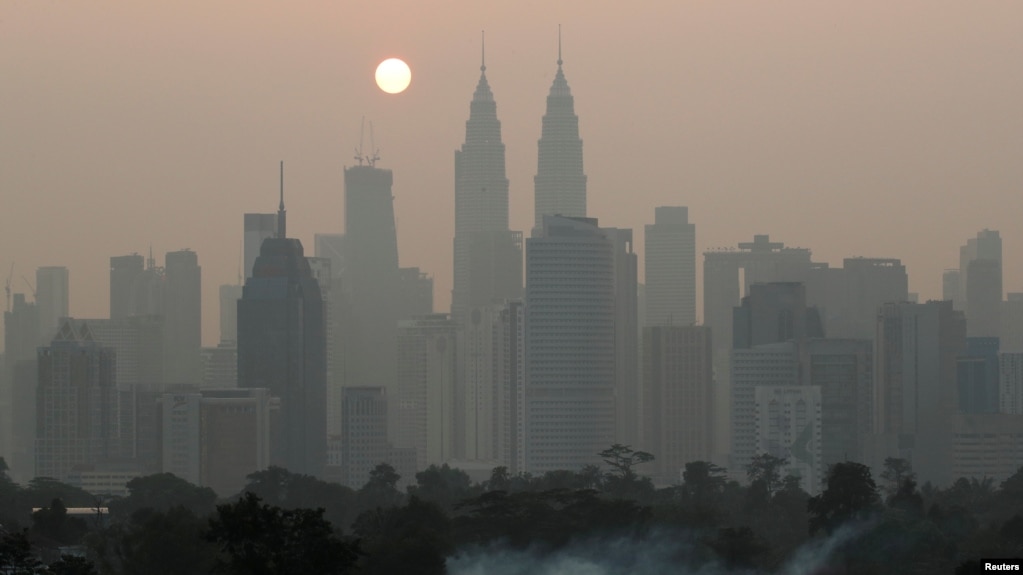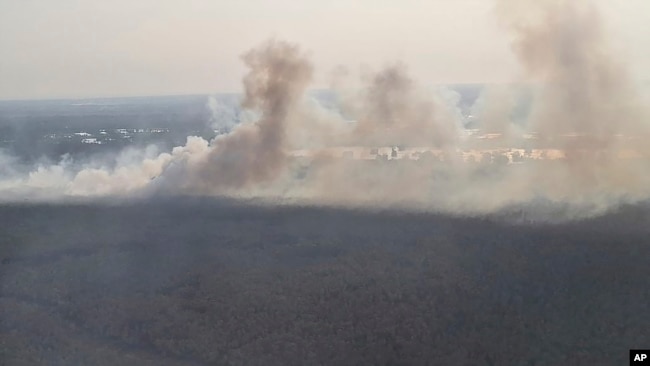What Is Causing Toxic Smoke across Southeast Asia?

The problem of cross-country smoke, or haze, has caused a new disagreement in Southeast Asia.
Malaysia’s environment minister wrote to Indonesia’s government this week calling for action to help reduce smoke across Malaysia.
The letter comes just weeks after countries in Southeast Asia agreed to a haze-free area by 2030.
What is going on?

Riders wear mask as they pass through the haze from forest fires in Palembang, South Sumatra, Indonesia, Friday, Oct. 6, 2023. (AP Photo/Muhammad Hatta)
In recent weeks, air quality reports in parts of Malaysia and Indonesia have reached readings above 150. This puts conditions at a level where people can experience unhealthy effects. And those with existing health problems could suffer greater greater health problems.
On the Indonesian side of Borneo Island, visibility was reduced to less than 10 meters. Schools are closed in both Indonesia and Malaysia to reduce the health effects on young children.
Malaysia has blamed the haze on Indonesia, saying smoke from forest fires is being pushed across the border.
Every few years, during the dry season, smoke from “slash and burn” land clearing takes over much of the area. Slash and burn is a method in agriculture to cut down and burn plants to clear land for planting.
This method is used to clear land for planting palm trees. Products from palm trees include oil, pulp, and paper. But this method threatens public health, education, and businesses like tourism.
How are officials dealing with the problem?

This photo released by Banjarmasin Disaster Management Agency, shows a fire that razes through a land in Banjarmasin, South Kalimantan, Indonesia, Friday, Oct. 6, 2023. (Banjarmasin Disaster Management Agency via AP)
Even after Malaysia called on Indonesia this week to avoid “normalizing” the haze, Indonesian officials have denied any responsibility.
Indonesia’s environment minister Siti Nurbaya Bakar said recently that forest fires had decreased and no haze was found moving toward any neighboring country.
She said Indonesia has been dealing with the fires by dropping water bombs from helicopters.
In the past, Indonesia has taken legal action against companies suspected of illegal burning. But each year fires continue with different degrees of severity.
In 2015 and 2019, Indonesia saw large fires that burned millions of hectares of land. It caused record-breaking pollution and some places were surrounded by toxic yellow smoke.
Why does this keep happening?
Under Indonesian law, burning by small, local farmers is permitted. But it must happen on an area no greater than two hectares and necessary prevention measures must be in place.
All large farm holders must follow sustainable palm oil standards, which do not permit burning.
The rules mean that slash and burn methods continue to be used by small-holder farmers. Additionally, following the guidelines is voluntary.
Unclear supply chains, land claims, and laws mean that large companies can sometimes avoid responsibility for illegal land clearing. The large operations are sometimes owned by companies based in countries like Malaysia and Singapore.
How is the area responding?
The Association of Southeast Asian Nations (ASEAN) recently launched a center for Transboundary Haze Pollution Control (known as ACC THPC).
Its aim is to help members prevent, deal with, and follow cross-country haze. The center is in line with ASEAN’s agreement to reach a haze-free area by 2030.
This week ASEAN agriculture and forestry ministers also agreed to take collective action to reduce and eventually remove crop burning.
Is climate change making it worse?
Environmentalists say Indonesia is home to the world’s third-largest rainforest area and the government needs to take more action. The country is experiencing increased dry conditions because of a weather system called El Niño.
Greenpeace Indonesia says climate warming is making forest and land fires more intense, which is adding to the climate crisis.
________________________________________________
Words in This Story
visibility – n. the ability to see or be seen
sustainable – adj. involving methods that do not completely use up or destroy natural resources
supply chain – n. a network of businesses that supply the materials and parts needed to provide people with products and goods
https://learningenglish.voanews.com/a/what-is-causing-toxic-smoke-across-southeast-asia-/7304868.html